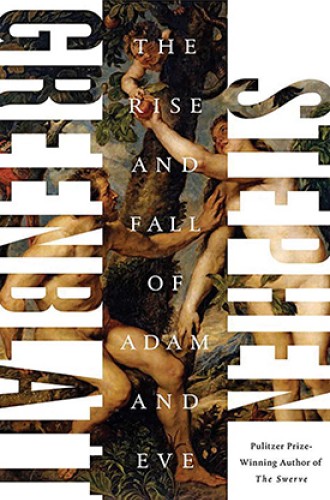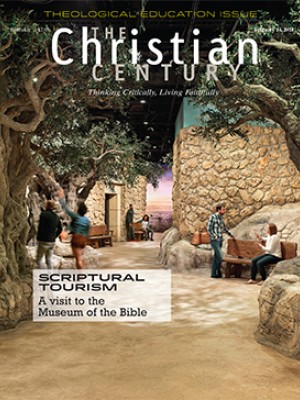The many lives of Adam and Eve
Stephen Greenblatt weaves an impressive—but incomplete—tapestry of interpretations of the story of the Fall.
Many people today view the biblical story of the first man and woman to be a charming if fanciful tale. But over 2,000 years ago, when Jews and then Christians began to record their interpretations of the scriptures, Adam and Eve’s fall was broadly regarded as a devastating story that held the secrets to human existence. These interpreters came to believe that if they could understand the nature of this story, the doors to understanding would open. Questions about humanity’s relationship with the divine, the origin of sin, the source of human mortality, and the nature of sexuality would all be answered. For these readers, the story of Adam and Eve was a minefield of theological meaning.
As he weaves through early Jewish texts and early, medieval, and modern Christian texts and art, Stephen Greenblatt discerns a pattern of interpretation that alternated between symbolic and literal readings, marked by a few significant turning points. While Jews and Christians in ancient times read the story metaphorically, Christians following Augustine read the story as a cautionary tale that was also historically accurate. In the Enlightenment, however, interpreters returned to the notion that the story of Adam and Eve was only a myth.
Read our latest issue or browse back issues.
Greenblatt is a master of close analysis. His passing comment that Adam and Eve possess the capacity to speak at the moment they are created is an insight that many of us miss when reading the story. And it’s a significant one: it raises questions about Adam and Eve’s relationship with the animal kingdom, which is not created with ability to speak, and about the methods by which the author chooses to include or exclude various aspects of the story. It also suggests that the story was never meant to be read as a historical archive.
Greenblatt observes medieval Christian art with such insight that I shook my head at not having seen earlier what he points out. Most of his analyses of visual depictions of the garden story are so spot-on that in retrospect they seem obvious.
In particular, his analysis of Albrecht Dürer’s 1504 portrait Adam and Eve displays the ease with which he explores artistic detail to discern a piece’s central message. Greenblatt notes, for instance, that in the lower left corner of the engraving, Adam’s right foot is raised slightly above ground and looks as if it is about to step on a mouse’s tail. The mouse, in turn, is being eyed hungrily by a cat poised to pounce. Given that Dürer is capturing the moment before Adam eats the forbidden fruit, this detail implies that Adam will step on the mouse’s tail and eat the fruit at the same time. Once Adam traps the mouse and partakes of the fruit, the harmonious system of life that God has created will crumble, and this crumbling will be encapsulated in the cat’s attack.
In some cases, however, Greenblatt’s readings border on speculation. In the midst of his erudite chapters on Milton, for instance, he imagines how the clash between Anglicans and Puritans affected Milton’s marriage, concluding that Milton believed that by marrying he would enter paradise. Other passages stray from any serious analysis at all, and Greenblatt glosses over early texts such as The Life of Adam and Eve and the midrash Genesis Rabbah, which were widely circulated among Christians and Jews, respectively, in antiquity. The lack of evenness here makes one wonder whether the metaphoric/literalist pattern of interpretation that he argues for is artificial.
As an orthodox Jew, I was bewildered by Greenblatt’s method of selecting sources. In his effort to trace a development of attitudes toward Adam and Eve over time, Greenblatt loses sight of the varied and well-circulated interpretations of this story in medieval and modern Jewish tradition. He cites Jewish texts up until the early rabbinic sources, but he treats them as feeder material for Augustine and later Christian theologians who read the story literally.
Moreover, Paul’s theological argument that Adam is a foil to Jesus gets virtually no attention here, perhaps because it does not directly address Greenblatt’s question of whether early readers read the story literally. Paul’s reading of how Jesus comes to replace Adam must have been hugely influential for the literary and artistic representations of the garden story that Greenblatt seeks to understand.
Like Paul, medieval midrashic sources do not read the story of Adam and Eve’s fall literally—or more accurately, Jewish interpreters (Paul included) simply did not care whether the story of Adam and Eve really happened: its literalism was peripheral to its transcendent theological message. Early Jews and Christians didn’t think in terms of fiction and nonfiction. No one in antiquity reading Homer or Josephus evaluated their works based on whether their texts were objective purveyors of the truth.
I found myself wondering whether the texts and artistry that Greenblatt explores were really in conversation with the material that preceded them in the way he suggests. In some cases, Greenblatt’s subjects actively and creatively interpret the Adam and Eve story in a subversive (or subversively traditional) way. But other documents and depictions seem to be unconscious absorptions of complex tributaries of historic expression that reached the author or artist by varying means. For example, Greenblatt illuminates the revolutionary paintings of Adam and Eve made by Jan and Hubert van Eyck that are part of the Ghent Altarpiece. Yet he doesn’t discuss how these two panels relate to ten other interior panels and 12 exterior panels that are part of this massive masterpiece. Only in understanding how Adam and Eve relate to the other images can we understand how the images of Adam and Eve were meant to be understood.
Greenblatt frames his book with opening and closing chapters about dinosaurs and human evolution, implying that the “truth” today is defined by modern science. By structuring the book this way, Greenblatt suggests that there is an unresolvable tension between evidentiary science, which proves that humans originate from monkeys, and the origin story of Adam and Eve. He also includes a long section on flood stories in the ancient Near East, although it is unclear precisely what these flood stories have to do with the reception history of the garden story, unless it’s to imply that their existence somehow undermines the historicity of the biblical story. Again, however, I am not convinced that biblical interpreters of old were concerned about whether something happened. The more pressing question was how to theologically internalize the story.
Perhaps the most useful part of the book is its appendix, which comprises many of the interpretations that Greenblatt cites throughout his book—and others that he does not mention. Here, too, it surprises me that Greenblatt does not include such significant sources as Paul’s fifth chapter of Romans or post-rabbinic Jewish material.
Charting the course of any subject over thousands of years cannot yield a neat conclusion, but Greenblatt’s effort to synthesize difficult and varied material is impressive. While some readers might be frustrated by Greenblatt’s wide-lens approach, others will no doubt appreciate his accessible and intimate writing style, his ease and erudition when it comes to studying ancient texts and art, and his many insights that we would have surely missed without the help of his keen eye.






